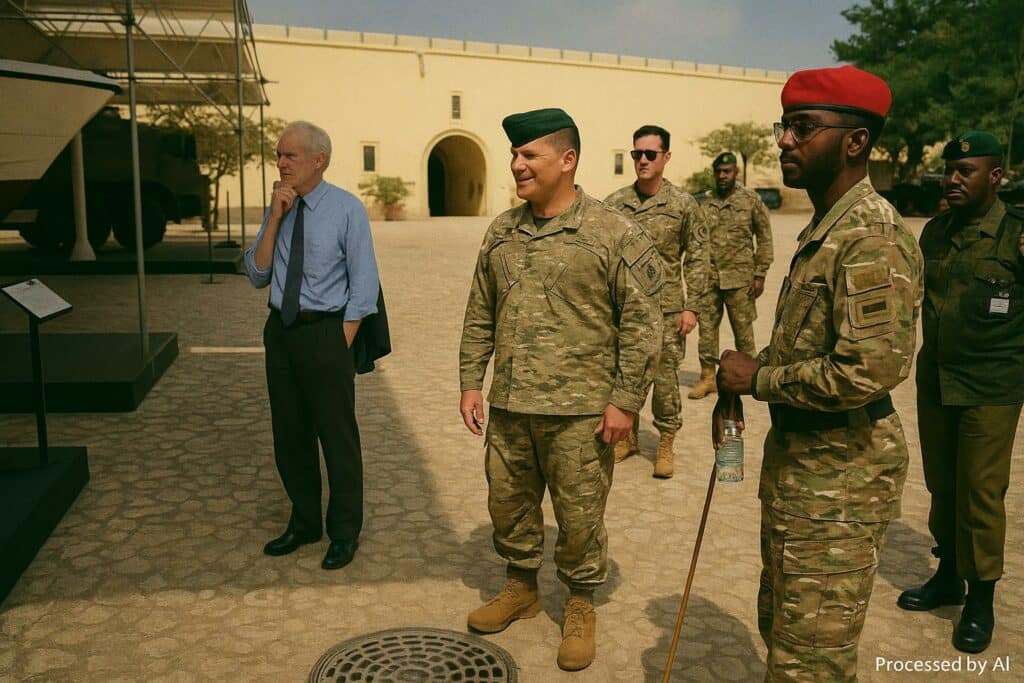Smolny’s Symbolic Berth in Central Africa
Shortly after sunrise on 28 July, the white-hulled training ship Smolny, attached to Russia’s Baltic Fleet, slid alongside the main quay of Pointe-Noire amid a flourish of brass instruments and ceremonial salutes. The Congolese prefectoral authorities, flanked by senior officers of the First Military Region, greeted Captain Igor Markov and his contingent of nearly four hundred sailors and cadets with honours that echoed beyond protocol. Both sides framed the port call as the tangible expression of a security dialogue that has quietly intensified since Brazzaville and Moscow signed a bilateral defence agreement in 2019 (Les Dépêches de Brazzaville).
At a moment when the Gulf of Guinea is drawing heightened attention for piracy, illicit trafficking and offshore energy installations, the image of a Russian ensign fluttering next to the Congolese tricolour carried a weight that transcends pageantry. Officials interviewed on the pier described the visit as a “working laboratory” for future joint activities, including coastal surveillance, hydrographic research and, eventually, combined exercises.
Historical Arc of Congo-Russian Defense Dialogue
Military contacts between the two capitals are not a novelty. Soviet advisers assisted the Congolese People’s Armed Forces as early as the 1960s, and periodic training exchanges persisted through the post-Cold War era. Yet the pace accelerated after President Denis Sassou Nguesso’s 2019 visit to Sochi, where a framework accord on defence cooperation was initialed. Since then, Congolese officers have attended instructor courses in Saint-Petersburg, and Russian technicians have serviced Mi-24 helicopters stationed at Maya-Maya airbase (TASS; Congolese Ministry of Defense communiqué, 2022).
The Smolny’s voyage therefore sits at the confluence of history and renewed pragmatism: Brazzaville seeks diversified partners in a fluid geopolitical market, while Moscow cultivates reliable footholds on the Atlantic façade of Africa at modest cost. Analysts from the African Center for Strategic Studies note that training ships, unlike combat flotillas, project influence without provoking regional alarm, allowing room for cooperative narratives around capacity building.
Cadet Training as Soft-Power Instrument
On board, two hundred naval cadets rotate through bridge watch, engine-room drills and cartographic exercises that would be routine on the Baltic Sea yet acquire new relevance off the Congo Basin. Captain Markov stressed that “exposure to equatorial currents, tropical downpours and multilingual port environments prepares future officers for blue-water deployments”. His counterpart, Rear Admiral Jean Olessongo Ondaye, highlighted the reciprocal dimension, inviting Russian instructors to observe Congolese coastal school facilities later this year.
Such exchanges convert pedagogy into diplomacy. As maritime strategist Pauline Bax observes, cadets who disembark, tour local markets and attend briefings at the Congo-Ocean Command nurture interpersonal bonds that can outlast formal treaties. For Brazzaville, the availability of scholarship slots in Russian academies supplements the domestic naval college, whose intake remains constrained by budgetary ceilings.
Local Reception and Cultural Resonance
Beyond the brass and braid, Pointe-Noire’s civil society encountered the visitors in softer hues. During a reception at the Maison du Port, Congolese guitarist Roga-Roga improvised with the ship’s small jazz ensemble, blending rumba rhythms with Slavic folk motifs to the delight of an audience that included students from the Lycée Victor-Augagneur. City prefect Pierre Cébert Iboko-Onanga remarked that “music often achieves in three minutes what diplomats negotiate for months”, a line that drew applause and discreet nods from Russian embassy staff.
Merchants near the Grand Marché reported brisk sales of carved mahogany souvenirs, while cadets queued for plates of saka-saka and grilled capitaine. Local newspapers emphasised the economic ripple effect, portraying the port call as a micro-stimulus for hospitality services battered by pandemic-era downturns.
Strategic Implications for Gulf of Guinea Security
Yet symbolism coexists with strategic calculus. The Congolese Navy operates a modest fleet of patrol craft charged with monitoring a 170-kilometre coastline dotted with oil terminals. According to International Maritime Organization figures, reported piracy incidents in the wider Gulf fell in 2022 but shifted southward, validating Brazzaville’s interest in external partnerships. Russian officers signal readiness to provide satellite imagery and electronic warfare training that can plug gaps in situational awareness.
For external observers, the Smolny’s presence also intersects with broader great-power competition. Washington’s maritime cooperation programs and Beijing’s construction of a pier extension at Pointe-Noire create a tri-angular dynamic. Diplomatic sources in Kinshasa nonetheless caution against over-dramatization, noting Brazzaville’s consistent policy of “multi-directional pragmatism” that welcomes assistance from any partner respectful of Congolese sovereignty.
Outlook for Bilateral Maritime Engagement
As the sun set over the Atlantic and the Smolny prepared for her next waypoint in Luanda, planners on both sides quietly drafted agendas. Proposals under review include a coastal radar upgrade financed through a concessionary loan, joint dives on Second World War wrecks near the Loango coastline and French-language immersion for Russian hydrographers.
Whether all or only some of these initiatives materialize, the port call has already delivered a clear message: Congo-Brazzaville intends to situate itself as an active, rather than peripheral, node in contemporary maritime diplomacy. By coupling ceremonial warmth with concrete staff talks, Brazzaville and Moscow have underscored a mutual intent to anchor their cooperation in practical seamanship and shared strategic interest, a course that, for now, sails with a favourable wind.

